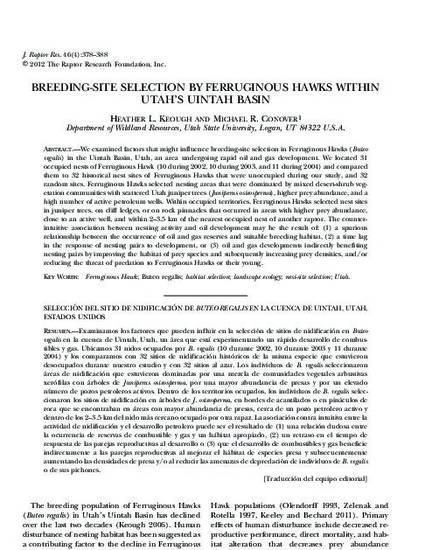
Article
Breeding-Site Selection By Ferruginous Hawks Within Utah's Uintah Basin
Journal of Raptor Research
(2012)
Abstract
We examined factors that might influence breeding-site selection in Ferruginous Hawks (Buteo regalis) in the Uintah Basin, Utah, an area undergoing rapid oil and gas development. We located 31 occupied nests of Ferruginous Hawk (10 during 2002, 10 during 2003, and 11 during 2004) and compared them to 32 historical nest sites of Ferruginous Hawks that were unoccupied during our study, and 32 random sites. Ferruginous Hawks selected nesting areas that were dominated by mixed desert-shrub vegetation communities with scattered Utah juniper trees (Juniperus osteosperma), higher prey abundance, and a high number of active petroleum wells. Within occupied territories, Ferruginous Hawks selected nest sites in juniper trees, on cliff ledges, or on rock pinnacles that occurred in areas with higher prey abundance, close to an active well, and within 2–3.5 km of the nearest occupied nest of another raptor. The counterintuitive association between nesting activity and oil development may be the result of: (1) a spurious relationship between the occurrence of oil and gas reserves and suitable breeding habitat, (2) a time lag in the response of nesting pairs to development, or (3) oil and gas developments indirectly benefiting nesting pairs by improving the habitat of prey species and subsequently increasing prey densities, and/or reducing the threat of predation to Ferruginous Hawks or their young.
Disciplines
Publication Date
2012
DOI
https://doi.org/10.3356/JRR-12-07.1
Citation Information
Michael Conover. "Breeding-Site Selection By Ferruginous Hawks Within Utah's Uintah Basin" Journal of Raptor Research Vol. 46 Iss. 4 (2012) p. 378 - 388 Available at: http://works.bepress.com/michael-conover/345/
